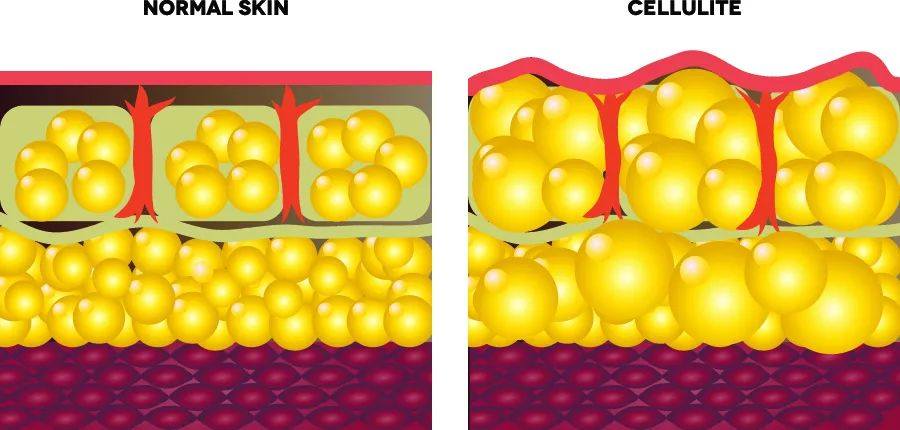It’s the season of not losing weight in March and sorrow in April, but to put on a good-looking skirt, besides losing weight, there is actually a particularly embarrassing problem, that is, the ugly orange peel tissue on the buttocks and legs.
What is an orange peel organization?
As the name implies, orange peel tissue looks like wrinkled orange peel, which is bumpy and easy to grow around our knee joints, above our thighs and buttocks.
To understand that what is orange peel tissue, we must first understand the skin structure.
Our skin is epidermis and dermis from shallow to deep.
The epidermis includes stratum corneum, transparent layer, granular layer, spinous layer and basal layer from shallow to deep.
The dermis layer consists of dense connective tissue, papillary layer and reticular layer in turn from shallow to deep. The reticular layer is connected with subcutaneous tissue and contains abundant collagen fibers, elastic fibers and reticular fibers. They interweave with each other to form a network, making the skin have greater elasticity and toughness.
As age increases and estrogen decreases, or fat decreases after weight gain, the strength and thickness of connective tissue between dermis and fat layer become uneven, so fat layer protrudes outward to dermis layer. When fat layer invades dermis layer unevenly, it will form clusters of localized fat masses.
In short, earlier orange peel tissue was related to the distribution of fat, which, to put it bluntly, was fatty lumps.

Why does orange peel tissue grow?
The appearance of orange peel tissue is usually related to the combined effect of many factors.
On the one hand, it is related to internal factors such as metabolism and hormone changes, genetic susceptibility, oxidative stress and skin circulation disorders.
On the other hand, it is related to external factors, such as malnutrition, lack of physical activity, clothing discomfort, bad habits (smoking, alcohol abuse) and chronic stress.
Due to inevitable internal factors and our bad living habits, the occurrence and development of cellulite may accelerate significantly and lead to irreversible changes in the body.
How Reduces Orange Peel Organization?
Although orange peel tissue is harmless to human health, we also hope to reduce cellulite as much as possible for the sake of beauty. So, we might as well start from the following aspects:
1. Weight Training
Weight training is a kind of exercise method that we often see in gymnasiums to exercise muscle endurance (assisted by equipment). It can adjust muscles and increase the level of exercise in deep tissues, which will help prevent cellulite accumulation.

Fast aerobic exercise is also a good method, such as cycling, running or walking fast.
You can also squeeze any part of your buttocks in your standing position, sitting position and lying position for about 10 seconds and then repeat this cycle for 10-15 times at intervals of 5 seconds. This is helpful to relax your buttocks and reduce the formation of cellulite.
2, Try to avoid sugar and fat intake
Limiting sugar and fat in food and eating more nuts, vegetables and fruits will help regulate body functions and promote metabolism.
This will help us lose too much weight and have healthy skin.
3. Reduce Alcohol Intake
Reducing drinking, smoking and even quitting smoking can help prevent orange peel tissue.
In addition, the use of cellulite treatment products, coupled with regular exercise, can also effectively prevent cellulite formation. However, it often takes more than a month or even longer to see the effect.
How to treat orange peel tissue?
1. Laser therapy
Clinically, laser can increase the natural thickness of skin and make skin smoother and healthier.
Pulsed laser transmits 1440 nm of light energy to the skin-subcutaneous interface, which has been proved to improve the dermal structure of orange peel tissue appearance.
2. Ultrasound therapy
Ultrasonic waves can guide high-energy waves that, when they encounter body tissues, produce microbubbles made up of vapor. Microbubbles are generated in adipose tissue and interstitial fluid, and they expand and contract in the process of continuous energy conversion.
Soon, adipocytes will implode and the water and fat in them will be released into the tissues of the body. Then, the liquid and fat will be absorbed by the liver and processed and transported out of the body.
3. Massage
In fact, orange peel tissue does not necessarily need to go to plastic surgery. Some traditional massage techniques can not only provide comfort, but also have certain effects. However, more evidence is needed to prove it.
Firming skin is won by ourselves. We should use sweat to say [NO] to the pig-killing knife of the years!
